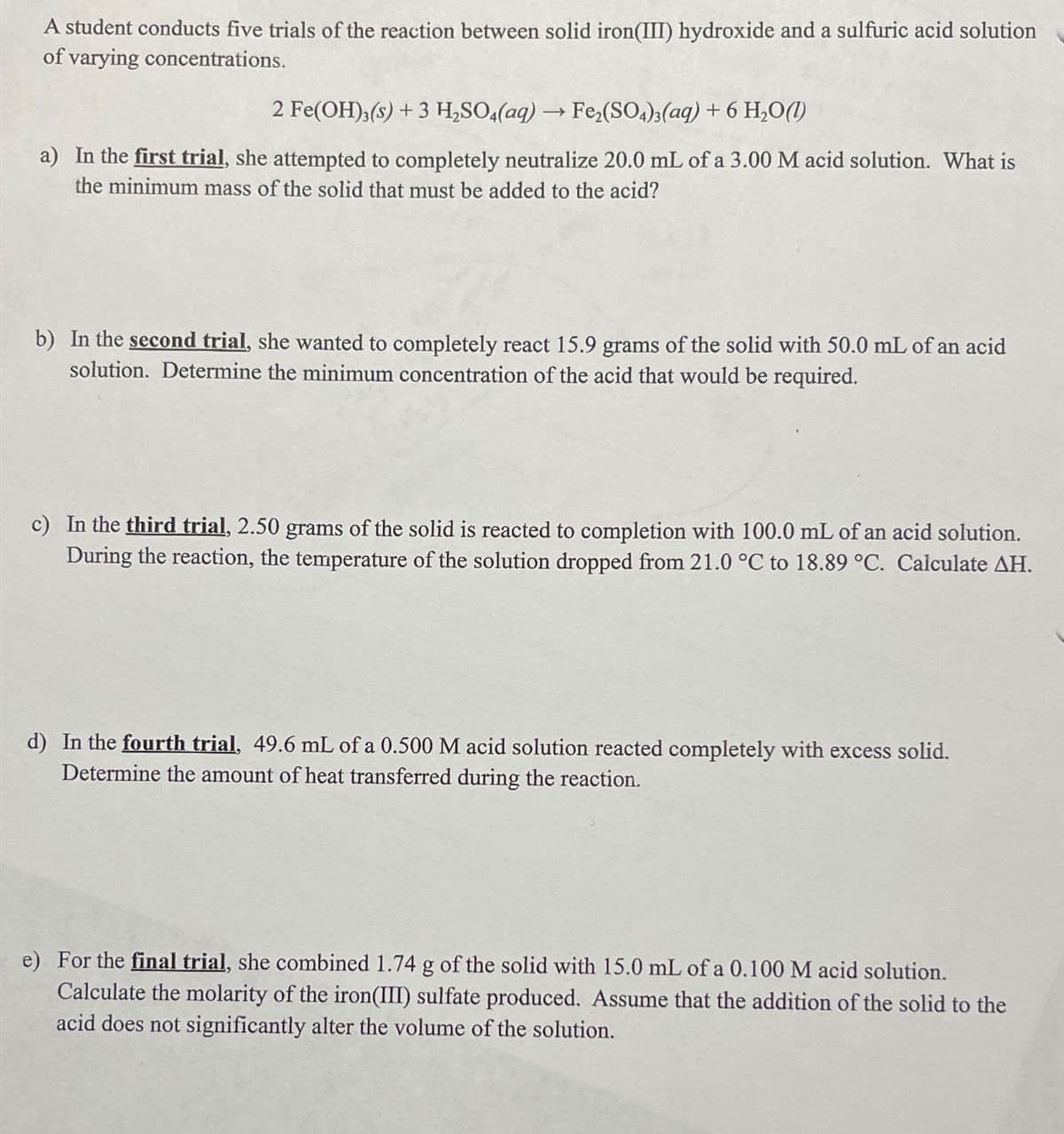2 Fe(OH);(s) + 3 H,SO,(aq) → Fe,(SO,)3(aq) + 6 H,O(1) a) In the first trial, she attempted to completely neutralize 20.0 mL of a 3.00 M acid solution. What is the minimum mass of the solid that must be added to the acid? b) In the second trial, she wanted to completely react 15.9 grams of the solid with 50.0 mL of an acid solution. Determine the minimum concentration of the acid that would be required.
2 Fe(OH);(s) + 3 H,SO,(aq) → Fe,(SO,)3(aq) + 6 H,O(1) a) In the first trial, she attempted to completely neutralize 20.0 mL of a 3.00 M acid solution. What is the minimum mass of the solid that must be added to the acid? b) In the second trial, she wanted to completely react 15.9 grams of the solid with 50.0 mL of an acid solution. Determine the minimum concentration of the acid that would be required.
General Chemistry - Standalone book (MindTap Course List)
11th Edition
ISBN:9781305580343
Author:Steven D. Gammon, Ebbing, Darrell Ebbing, Steven D., Darrell; Gammon, Darrell Ebbing; Steven D. Gammon, Darrell D.; Gammon, Ebbing; Steven D. Gammon; Darrell
Publisher:Steven D. Gammon, Ebbing, Darrell Ebbing, Steven D., Darrell; Gammon, Darrell Ebbing; Steven D. Gammon, Darrell D.; Gammon, Ebbing; Steven D. Gammon; Darrell
Chapter4: Chemical Reactions
Section: Chapter Questions
Problem 4.130QP: Arsenic acid, H3AsO4, is a poisonous acid that has been used in the treatment of wood to prevent...
Related questions
Question

Transcribed Image Text:A student conducts five trials of the reaction between solid iron(III) hydroxide and a sulfuric acid solution
of varying concentrations.
2 Fe(OH)3(s) + 3 H,SO4(aq) →Fe,(SO4)3(aq) + 6 H,O(1)
a) In the first trial, she attempted to completely neutralize 20.0 mL of a 3.00 M acid solution. What is
the minimum mass of the solid that must be added to the acid?
b) In the second trial, she wanted to completely react 15.9 grams of the solid with 50.0 mL of an acid
solution. Determine the minimum concentration of the acid that would be required.
c) In the third trial, 2.50 grams of the solid is reacted to completion with 100.0 mL of an acid solution.
During the reaction, the temperature of the solution dropped from 21.0 °C to 18.89 °C. Calculate AH.
d) In the fourth trial, 49.6 mL of a 0.500 M acid solution reacted completely with excess solid.
Determine the amount of heat transferred during the reaction.
e) For the final trial, she combined 1.74 g of the solid with 15.0 mL of a 0.100 M acid solution.
Calculate the molarity of the iron(III) sulfate produced. Assume that the addition of the solid to the
acid does not significantly alter the volume of the solution.
Expert Solution
This question has been solved!
Explore an expertly crafted, step-by-step solution for a thorough understanding of key concepts.
This is a popular solution!
Trending now
This is a popular solution!
Step by step
Solved in 2 steps with 1 images

Knowledge Booster
Learn more about
Need a deep-dive on the concept behind this application? Look no further. Learn more about this topic, chemistry and related others by exploring similar questions and additional content below.Recommended textbooks for you

General Chemistry - Standalone book (MindTap Cour…
Chemistry
ISBN:
9781305580343
Author:
Steven D. Gammon, Ebbing, Darrell Ebbing, Steven D., Darrell; Gammon, Darrell Ebbing; Steven D. Gammon, Darrell D.; Gammon, Ebbing; Steven D. Gammon; Darrell
Publisher:
Cengage Learning

Chemistry for Engineering Students
Chemistry
ISBN:
9781337398909
Author:
Lawrence S. Brown, Tom Holme
Publisher:
Cengage Learning


General Chemistry - Standalone book (MindTap Cour…
Chemistry
ISBN:
9781305580343
Author:
Steven D. Gammon, Ebbing, Darrell Ebbing, Steven D., Darrell; Gammon, Darrell Ebbing; Steven D. Gammon, Darrell D.; Gammon, Ebbing; Steven D. Gammon; Darrell
Publisher:
Cengage Learning

Chemistry for Engineering Students
Chemistry
ISBN:
9781337398909
Author:
Lawrence S. Brown, Tom Holme
Publisher:
Cengage Learning


Chemistry
Chemistry
ISBN:
9781305957404
Author:
Steven S. Zumdahl, Susan A. Zumdahl, Donald J. DeCoste
Publisher:
Cengage Learning

Chemistry: An Atoms First Approach
Chemistry
ISBN:
9781305079243
Author:
Steven S. Zumdahl, Susan A. Zumdahl
Publisher:
Cengage Learning

Chemistry by OpenStax (2015-05-04)
Chemistry
ISBN:
9781938168390
Author:
Klaus Theopold, Richard H Langley, Paul Flowers, William R. Robinson, Mark Blaser
Publisher:
OpenStax